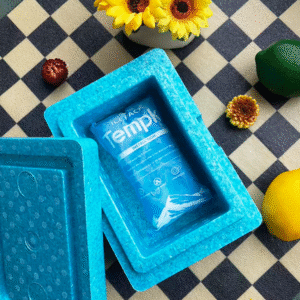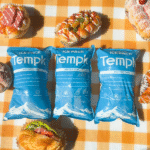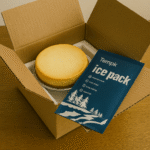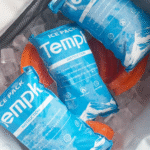Paquetes de hielo seco farmacéuticos: Guía esencial para 2025 Logística de cadena de frío
Shipping pharmaceutical products, especially temperature-sensitive medications, requires strict temperature control to ensure their efficacy. Pharmaceutical dry ice packs provide a reliable solution for maintaining these temperatures, ensuring that medications, vacunas, and biologics remain safe throughout their journey. This guide will explore the importance of dry ice packs in pharmaceutical logistics, how to use them optimally, and the trends shaping the shipping of temperature-sensitive drugs in 2025.
-
Why pharmaceutical dry ice packs are critical for safe medication shipping.
-
How to choose the right dry ice pack based on specific pharmaceutical products.
-
The advantages of dry ice over other cooling methods en la industria farmacéutica.
-
Mejores prácticas for using dry ice to maintain temperature-sensitive medications during transit.
Why Are Pharmaceutical Dry Ice Packs Important for Safe Medication Shipping?
Pharmaceutical dry ice packs are essential for maintaining ultra-low temperatures required by sensitive medical products such as vaccines, biológicos, y enzimas. El hielo seco se sublima directamente de un sólido a un gas, which helps maintain a consistent temperature without the risk of water leakage or product contamination. This makes dry ice a critical component in ensuring pharmaceutical products stay within required temperature ranges, reducing the risk of spoilage or loss of efficacy during transit.
Benefits of Pharmaceutical Dry Ice Packs
-
Duración de enfriamiento más larga: Dry ice can maintain temperatures as low as -78.5°C for several days, making it ideal for shipments requiring temperatures as low as -20°C to -70°C.
-
No Water Damage Risk: A diferencia del hielo tradicional, El hielo seco se sublima en gas, leaving no liquid water that could damage products or packaging.
-
Control preciso de la temperatura: Dry ice ensures a consistent cooling effect, crucial for maintaining the integrity of temperature-sensitive medical products over long distances and durations.
How to Choose the Right Pharmaceutical Dry Ice Pack
Selecting the appropriate dry ice pack depends on several key factors, such as the product’s temperature requirements, la duración del envío, y el tamaño del envío. Here’s how to ensure optimal dry ice usage:
Key Considerations for Dry Ice Selection
-
Requisitos de temperatura del producto: Vaccines and biologics often need to be stored at ultra-low temperatures. Dry ice is ideal for meeting these stringent requirements, keeping products at the correct temperature for extended periods.
-
Duración del envío: The amount of dry ice required increases with the duration of shipping. Por ejemplo, a 72-hour shipment may need more dry ice than a 24-hour one. It’s essential to calculate dry ice needs based on the shipping time.
-
Packaging Size and Weight: Larger shipments require more dry ice to maintain temperature control, especially when shipping bulk quantities.
Ejemplo: Dry Ice Requirement Based on Product and Duration
| Producto farmacéutico | Se necesita hielo seco (por 24 horas) | Rango de temperatura | Duración de envío |
|---|---|---|---|
| Vacunas | 1-2 libras | -20° C a -70 ° C | 24-72 horas |
| Biológicos | 3-5 libras | -20° C a -50 ° C | 24-72 horas |
| Temperature-Sensitive Drugs | 2-3 libras | -10° C a -20 ° C | 24-48 horas |
| Enzyme Samples | 4-6 libras | -20°C a -60°C | 48-72 horas |
Advantages of Using Dry Ice Over Other Cooling Methods
Longer-Lasting Cooling Effect
Dry ice’s ability to maintain sub-zero temperatures for days makes it a superior option compared to traditional ice, which can melt quickly and fail to maintain the necessary cold chain.
No Risk of Water Damage
Hielo tradicional, once it melts, produces water that could seep into packaging and potentially damage medical products. hielo seco, sin embargo, sublimada directamente en gas, eliminating the risk of water damage.
Ideal for Ultra-Low Temperature Control
Dry ice is particularly effective for pharmaceuticals requiring ultra-low temperatures, como las vacunas de ARNm. It maintains consistent cold conditions throughout long-distance and multi-day shipments.
Caso del mundo real: A pharmaceutical company shipping vaccines globally reported that dry ice provided reliable temperature control over 72 horas, whereas using regular ice resulted in temperature fluctuations that compromised the vaccine quality.
Best Practices for Using Pharmaceutical Dry Ice Packs
Embalaje adecuado
Choose insulated packaging that helps slow down the sublimation of dry ice. Vacuum-insulated containers are ideal for long-distance shipments as they provide superior temperature retention, while foam containers are sufficient for shorter shipments.
Layering Dry Ice Effectively
Place dry ice at the bottom of the container to ensure cold air naturally flows downwards. Make sure there is enough space for the CO₂ gas to escape, as the sublimation process can cause pressure build-up if not properly vented.
Sistemas de monitoreo de temperatura
Use real-time temperature monitoring systems, such as IoT-enabled sensors, to track the temperature of pharmaceutical shipments during transit. These devices ensure that the product stays within the desired temperature range, providing peace of mind and reducing risks.
2025 Trends in Pharmaceutical Cold Chain Logistics
En 2025, technological advancements are shaping the future of pharmaceutical cold chain logistics. Here are some notable trends:
Soluciones de embalaje inteligentes
Smart packaging equipped with IoT sensors is gaining popularity. These sensors monitor temperature, humedad, y ubicación en tiempo real, ensuring that temperature-sensitive pharmaceutical products are kept under optimal conditions throughout transit.
Sustainable Shipping Practices
A medida que aumentan las preocupaciones medioambientales, the pharmaceutical logistics industry is turning to more eco-friendly solutions. These include biodegradable packaging and innovations in reducing the carbon footprint of cold chain operations.
Ideas del mercado
Por 2025, the pharmaceutical cold chain logistics market is projected to surpass $120 mil millones. This growth is driven by the increasing demand for temperature-sensitive drugs and the widespread use of dry ice for pharmaceutical shipments.
Preguntas frecuentes (Preguntas frecuentes)
How much dry ice is needed to ship pharmaceutical products?
The amount of dry ice depends on the product, Duración de envío, y requisitos de temperatura. Generalmente, 1-2 libras de hielo seco por 24 hours is sufficient for most pharmaceutical shipments.
Can dry ice be used for shipping temperature-sensitive drugs?
Sí, dry ice is ideal for shipping temperature-sensitive drugs that need to stay within a specific temperature range. It ensures that the products remain cold without the risk of water leakage.
Conclusión y recomendaciones
Pharmaceutical dry ice packs are essential for the safe shipping of temperature-sensitive medications. By understanding the best practices for using dry ice, selecting the right packaging, and keeping up with the latest trends in logistics, pharmaceutical companies can ensure the integrity of their products during transit.
Consejos prácticos:
-
Calculate the necessary dry ice based on the shipping duration and product needs.
-
Ensure proper handling and ventilation of dry ice to avoid safety risks.
-
Stay updated on the latest trends in sustainable cold chain logistics.
Acerca de Tempk
Y tempk, we specialize in providing innovative cold chain solutions tailored to the pharmaceutical industry. Nuestras bolsas de hielo seco, Sistemas de monitoreo de temperatura, and advanced packaging technologies ensure that your sensitive pharmaceutical products are transported safely and efficiently. Reach out to us for a consultation to optimize your cold chain operations.
Siguientes pasos: Contact Tempk for expert advice on optimizing pharmaceutical shipping or learn more about our sustainable shipping solutions.
























